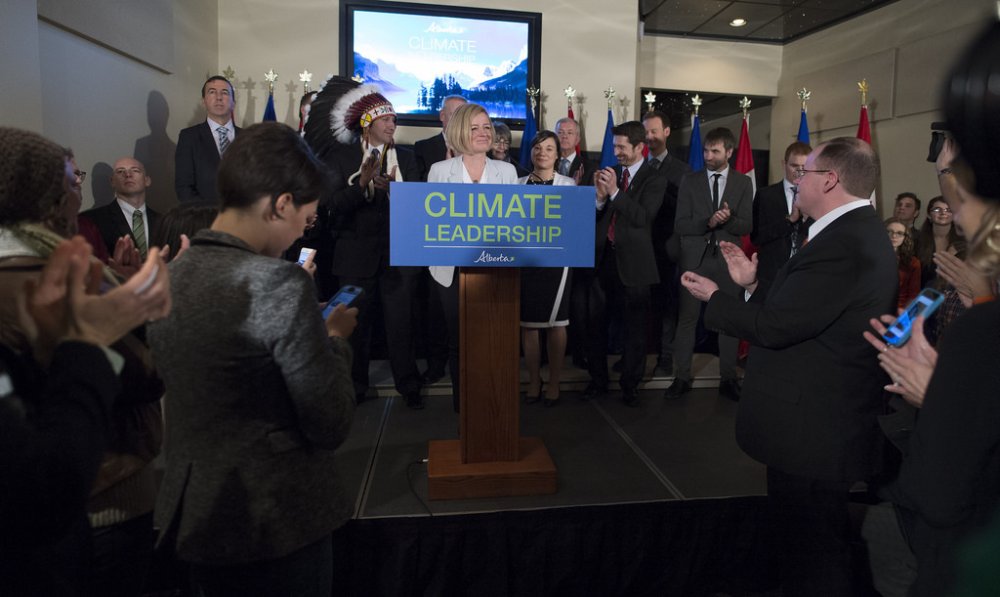The sweeping new climate protection policy announced recently by Alberta Premier Rachel Notley has been hailed as a game changer by industry and environmentalists alike. Overnight, a province whose bread and butter is oil and gas took a giant step forward on a greenhouse-gas pollution strategy, sending an important signal to the rest of Canada and the world.
Attention has mostly focused on plans to set a price on carbon and replace coal-fired electricity with renewables and natural gas. But there’s also a secret weapon in the policy that can help achieve millions of tonnes of reductions quickly and cost-effectively. That weapon is methane, vast amounts of which are released by the oil-and-gas industry each year through leaks, malfunctions and intentional discharges.
The problem with methane
Methane is the main ingredient in natural gas. Unburned, it packs over 80 times the warming power of carbon dioxide over a 20-year time frame. Reducing these emissions by cutting needless waste is by far the most important thing we can do to curtail warming right now while longer-term carbon reductions take hold.
Worldwide, about 99 billion cubic metres of methane worth nearly $40-billion escaped from oil and gas operations in 2012, with climate impacts equal to 40 per cent of total global coal combustion, according to the Rhodium Group. Canada is the world’s fourth-largest emitter, behind Russia, Uzbekistan and the United States. The short-term impact of Canada’s emissions is equal to the annual greenhouse emissions of almost 40 million vehicles.
If you haven’t heard much about methane in the climate debate, you’re not alone. But the International Energy Agency ranks cutting oil and gas methane at the same level of effectiveness as increased investment in renewable energy. Ms. Notley says the impact of the planned cuts is “not far from the reductions we will achieve from phasing out coal.”
A goal within reach
Alberta’s new climate strategy aims to reduce oil and gas methane emissions by 45 per cent by 2025, a goal that could be achieved for an average of less than a penny per thousand cubic feet of gas produced, according to a study by ICF International.
Real-world results are equally encouraging. In Colorado, which recently enacted the first direct limits on methane in the United States, one major producer reported that its compliance costs were just three-tenths of 1 per cent of its yearly capital budget. What’s more, statewide oil-field employment grew 16 per cent in 2014 – adding nearly 4,000 new jobs.
Of course, goals are only as good as the concrete policies behind them. As Ms. Notley and others move to the implementation phase, it’s important not to let this opportunity get watered down. In particular, officials must follow through on the announcement that they will develop regulations not just for new sources, but also for thousands of existing wells, pipelines and other facilities.
Canada-wide potential
Alberta’s bold stroke also sets the bar for others. The advisory team established by Premier Christy Clark recommended a similar methane goal for British Columbia. And Catherine McKenna, Canada’s first Minister of Environment and Climate Change, could deliver the benefits of methane emission reduction for Canada as a whole by adopting a national methane target.
If Canada were to adopt a 45-per-cent reduction goal like Alberta, coupled with the White House’s 40- to 45-per-cent target for the oil and gas sector, our two countries alone could reduce global oil and gas methane emissions by almost 10 per cent. If every gas-producing country matched those targets, it would have the same 20-year effect as closing 1,000 coal-fired power plants. That’s a pretty significant down payment for global action.
Alberta’s commitment gives Canada’s new federal government something to brag about at the climate talks in Paris. If Ottawa were to announce a national methane reduction target in its first 90 days in power, it would further demonstrate that Canada really has rejoined the rest of the world in the effort to prevent dangerous climate change.
Ed Whittingham is executive director of the Pembina Institute. Fred Krupp is president of the (U.S.) Environmental Defense Fund.







